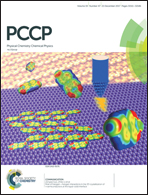Kinetic alteration of the 6Mg(NH2)2–9LiH–LiBH4 system by co-adding YCl3 and Li3N†
Abstract
The 6Mg(NH2)2–9LiH–LiBH4 composite system has a maximum reversible hydrogen content of 4.2 wt% and a predicted dehydrogenation temperature of about 64 °C at 1 bar of H2. However, the existence of severe kinetic barriers precludes the occurrence of de/re-hydrogenation processes at such a low temperature (H. Cao, G. Wu, Y. Zhang, Z. Xiong, J. Qiu and P. Chen, J. Mater. Chem. A, 2014, 2, 15816–15822). In this work, Li3N and YCl3 have been chosen as co-additives for this system. These additives increase the hydrogen storage capacity and hasten the de/re-hydrogenation kinetics: a hydrogen uptake of 4.2 wt% of H2 was achieved in only 8 min under isothermal conditions at 180 °C and 85 bar of H2 pressure. The re-hydrogenation temperature, necessary for a complete absorption process, can be lowered below 90 °C by increasing the H2 pressure above 185 bar. Moreover, the results indicate that the hydrogenation capacity and absorption kinetics can be maintained roughly constant over several cycles. Low operating temperatures, together with fast absorption kinetics and good reversibility, make this system a promising on-board hydrogen storage material. The reasons for the improved de/re-hydrogenation properties are thoroughly investigated and discussed.



 Please wait while we load your content...
Please wait while we load your content...